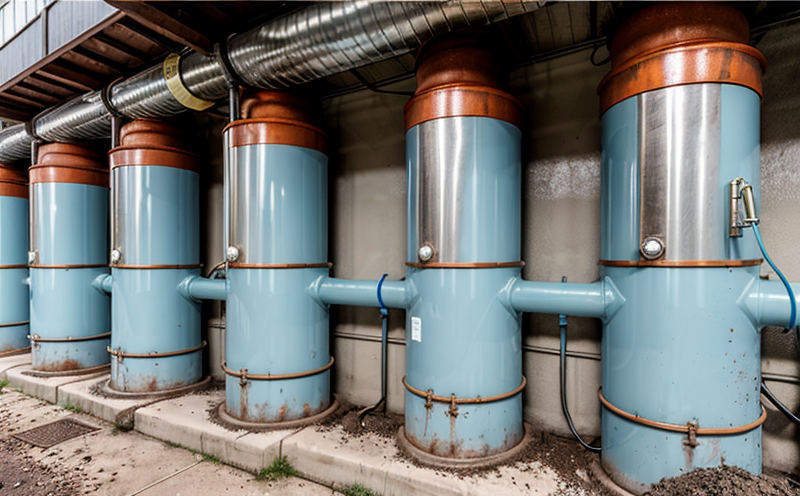ASTM G214 Scaling Rate Measurement Test in Water
The ASTM G214 scaling rate measurement test is a critical method used to assess the rate at which scale forms on metallic surfaces submerged in water. This test plays a vital role in ensuring that materials and systems used in water distribution, storage, and treatment are resistant to the formation of scale, which can lead to reduced efficiency, increased maintenance costs, and potential risks to public health.
The ASTM G214 standard is widely recognized for its comprehensive approach to measuring scaling rates. It involves submerging a metal specimen in water under controlled conditions, allowing the formation of scale deposits over a specified period. The test measures both the mass gain of the specimen due to the deposit and the dimensional changes that occur as a result.
Materials commonly used for this test include stainless steel, carbon steel, copper, brass, and alloys. The choice of material is crucial as it reflects real-world applications in water systems. The water used in ASTM G214 can be deionized water or natural water depending on the specific requirements of the study.
The test apparatus includes a controlled environment chamber that maintains the necessary temperature and humidity levels, ensuring consistent conditions for scaling formation. Specimens are typically exposed to water for periods ranging from several weeks to months, allowing sufficient time for scale deposition to occur. During this period, regular measurements are taken to monitor changes in mass and dimensions.
The ASTM G214 standard provides detailed acceptance criteria that specify the allowable limits of scaling rates under various conditions. Compliance with these standards ensures that materials meet industry requirements and can be trusted for long-term performance in water systems.
Understanding the principles behind ASTM G214 is essential for quality managers, compliance officers, R&D engineers, and procurement professionals who are responsible for selecting appropriate materials and ensuring their durability in water environments. This test not only aids in material selection but also helps in optimizing water treatment processes to minimize scaling issues.
Why Choose This Test
The ASTM G214 Scaling Rate Measurement Test is a preferred choice for several reasons:
- Comprehensive Assessment: It provides a holistic view of how materials perform in water, including both mass gain and dimensional changes.
- Regulatory Compliance: Meeting the standards ensures compliance with international regulations such as ISO, ASTM, EN, IEC, etc.
- Real-World Relevance: The test simulates actual conditions found in water systems, making it highly relevant for practical applications.
- Economic Benefits: By identifying materials prone to scaling early on, companies can make informed decisions that lead to cost savings and improved efficiency.
The ASTM G214 Scaling Rate Measurement Test is a cornerstone in the field of water & wastewater testing. It helps ensure that critical infrastructure remains operational and safe for extended periods, thereby supporting broader societal goals related to environmental sustainability and public health.
Environmental and Sustainability Contributions
The ASTM G214 Scaling Rate Measurement Test contributes significantly to environmental sustainability by promoting the use of materials that are resistant to scaling. This reduces the need for frequent maintenance, minimizes waste generation, and conserves resources. By ensuring that water systems operate efficiently, this test also helps in reducing energy consumption associated with water treatment processes.
- Reduces Maintenance Intervals: Materials that pass ASTM G214 are less likely to form scales, leading to longer intervals between maintenance activities.
- Minimizes Waste: The reduced need for frequent replacements translates into lower waste production and landfill burden.
- Conserves Resources: Efficient water systems help in optimizing the use of raw materials and energy, contributing to overall resource conservation.
The ASTM G214 Scaling Rate Measurement Test aligns with broader sustainability initiatives by fostering the development and use of sustainable technologies. By reducing scaling issues, this test also helps in maintaining water quality, which is crucial for protecting ecosystems and public health.
Use Cases and Application Examples
The ASTM G214 Scaling Rate Measurement Test finds application across various sectors including water treatment facilities, power plants, industrial processes, and residential plumbing systems. Here are some use cases:
| Use Case | Description |
|---|---|
| Water Treatment Plants | Evaluating the durability of pipes and valves used in water treatment processes. |
| Power Plants | Assessing the performance of cooling tower components to minimize scaling issues that can affect plant efficiency. |
| Industrial Processes | Determining the suitability of materials for use in industrial water systems, ensuring optimal operational conditions. |
| Residential Plumbing Systems | Selecting appropriate materials for new installations to ensure longevity and reduce maintenance costs. |
The following table provides more specific examples of how ASTM G214 is applied in different scenarios:
| Scenario | Material Tested | Expected Outcome |
|---|---|---|
| Corrosion Resistance Evaluation | Stainless Steel Pipes | Identify the rate of scaling and its impact on pipe integrity. |
| Water Quality Improvement | Copper Alloy Fittings | Evaluate the effectiveness of the alloy in preventing scaling buildup. |
| Energy Efficiency Assessment | Brass Valves | Determine if the valve material contributes to reduced energy consumption by minimizing scaling. |
These examples illustrate how ASTM G214 is integral to ensuring that materials used in water systems are both sustainable and effective, thereby supporting broader environmental and economic goals.





